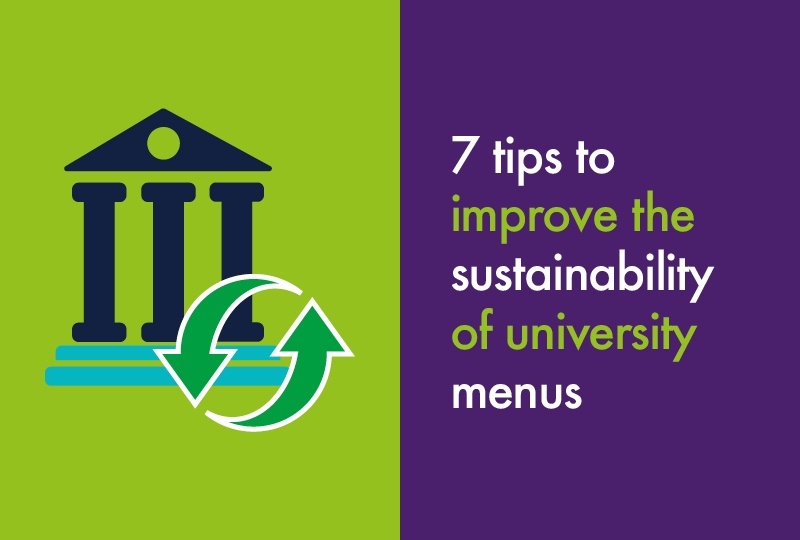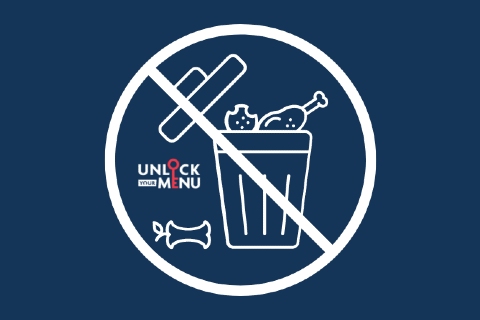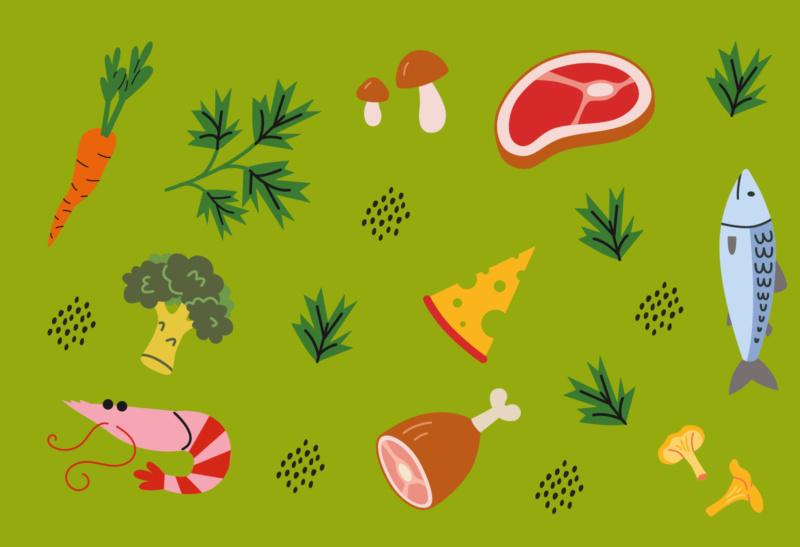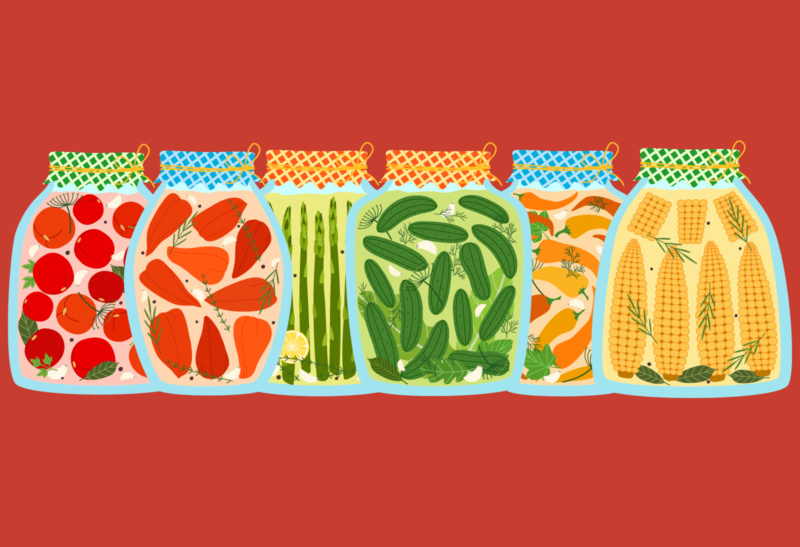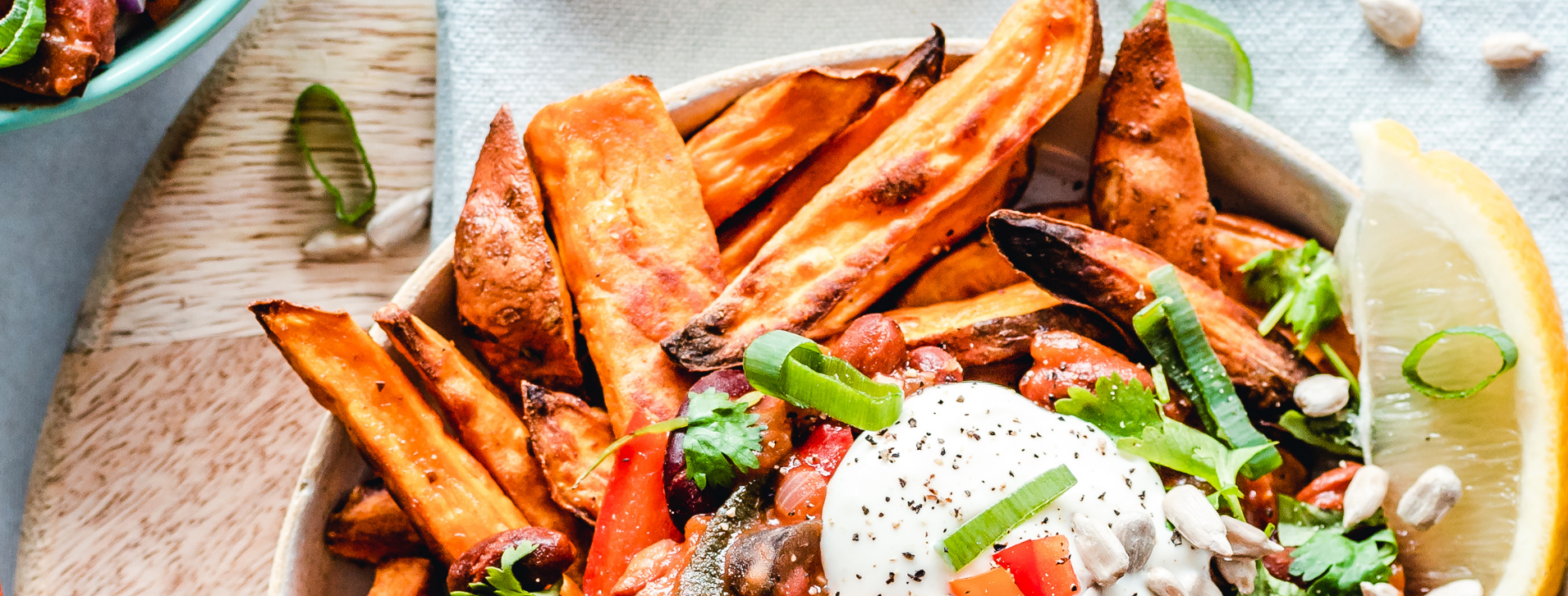A key element of this is what people eat – a recent report by WRAP has shown food and drink contribute to 35% of the UK’s greenhouse gases. Behaviour change can be hard to implement and slow to take hold, but our climate crisis continues to grow and we need to act now to limit global warming to 1.5°C to ensure we mitigate the worst impacts of climate change. Alongside this, to achieve a true sustainable future, we need to think holistically across all areas of sustainability, and avoid being stuck with ‘carbon tunnel vision’.
Students are flexible and open to change, so a university is a great place to bring in innovative ideas. By creating menus of the future, not only can we minimise the environmental and ethical impacts of what students eat now, we can inspire and educate them to continue to eat healthy and sustainable diets in the future.
Tip 1 – Eat more plants
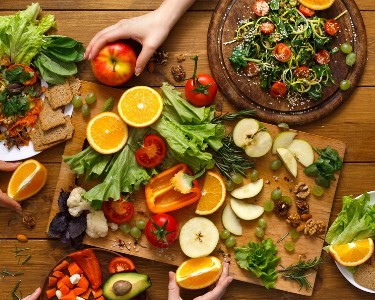
First on the list, but probably the most controversial, is to eat more plants, and use less meat, eggs and dairy. This is the single biggest change that you can make to your menu which will have the most impact on the environment. Multiple studies show meat has a higher carbon footprint than what most plants do, and that we need a major shift in diets to meet our climate goals.
But this is a tricky one to navigate in a society where meat is a traditional part of the diet and provides many nutritional properties that can be more difficult to get from plants. Remember, meat doesn’t have to be boycotted altogether, and students can be just the right people to try out new ideas. A common term used is ‘eat less and better’ meat, dairy and eggs, which involves using your buying power to support farmers doing better – look for free range and organic products where possible.
The Eat4Change campaign ran by WWF has some good suggestions for alternatives that can be included in popular meals. By increasing the proportion of plants in a meal, and ensuring any meat used is from a higher welfare system, you will impact all areas of sustainability – environmental, ethical and economical, which will be a key requirement for future menus.
Why not try out this tasty beef, oat and butterbean burger?
Also, think about what meat you are serving as part of the meal. Red meat has a bad rap for being one of the largest contributors to carbon emissions, yet beef cattle are typically outdoors and free to express their natural behaviour. They are surrounded by grass, plants and hedgerows often not considered in carbon footprint methodology but which offer habitat for wildlife and opportunities for further rewilding projects.
The majority of chicken in the UK is raised in intensive farms with large numbers of birds in each shed which although have a smaller carbon footprint, doesn’t offer anything back to the environment and these systems are criticised by animal welfare NGO’s.
If reducing meat is not an option, make sure to consider what unintended consequences there might be when switching from one meat type to another. Future diets need to be sustainable in all areas, so although we are facing a climate emergency, we must consider the ethical and economical sides of sustainability too.
Tip 2 – Make nuts and legumes the centre of attention
Following on from the tip on meat, it makes sense to move on to plants as these need to make up more of each menu. Nuts and legumes such as beans, peas and lentils are a good source of protein, have a small carbon and water footprint and are great for the soil reducing the need for fertilisers.
Our western diets demand meat and two veg, but more and more people are getting used to the idea of having more plants as part of a meal, and innovative dishes help to pull people in further. Young people are also keen to try new things and may be more willing to try the new dishes that you come up with. Just make sure that your recipes are tasty as well as healthy and sustainable, and you should be on to a winner.
Some ideas to get you started include our Hawaiian sweet potato salad and our Red lentil Chilli recipes.
Tip 3 – Make sure grains are whole, intact and less processed
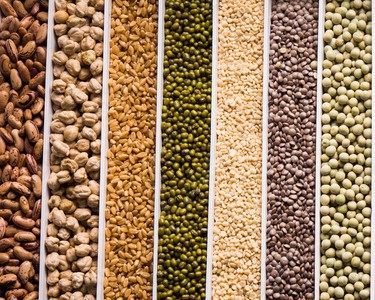
Try to replace refined grains with whole grains as they pack in lots more nutrients compared to refined grains, and according to the British Dietetic Association, also contribute to a number of health benefits such as lowering the risk of type 2 diabetes and heart disease. Probably not something that will be top of the mind for most students at the moment, but very important for their future diets.
Wholegrains can also be better for the planet, as they are less processed and therefore produce less waste, have a lower water requirement than other crops or livestock, and can help improve soil fertility and land use when rotated with other crops*.
Try to buy British where possible and in season, and think about using grains which are not as common to help create a more secure food system with a wide range of plants which helps to create resiliency. Grain in the UK is usually intensively farmed**, which requires the use of fertilisers and pesticides and the monocultures cause a lack of biodiversity in fields.
Farmers are starting to introduce more regenerative agriculture techniques such as introducing cover crops and rotating crops with animals that aim to tackle these issues.
Tip 4 – Know where your products are coming from
Supply chains have become increasingly complex and difficult to navigate, which can make it hard to know what you are really buying and to what standards food has been produced. One way to navigate this is by looking for products certified to food assurance schemes, which are then traceable and state within their standards the key criteria that you can expect from your products.
Bidfood offer a range of Red Tractor products which are traceable back to farm, guarantee the product is British and are audited against their standards to ensure products are high quality.
Buying locally will help to support the local economy, although it may not always provide the best products with the smallest footprint. Try to consider all elements of a product’s lifecycle when sourcing products, and buy seasonal where possible. This might mean importing food but it limits the amount of resources needed to grow food – often food miles are a much smaller part of a products footprint than thought.
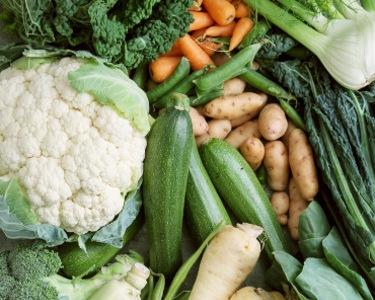
Think about the standards which you are buying – buying free range or organic meat provides animals with better conditions and improves their welfare. There are a few schemes which certify higher welfare products such as RSPCA and OF&G. Many companies, including Bidfood, have 2025 cage free eggs commitments and this is driving the whole industry to shift to barn and free range eggs, which offer much improved welfare for laying hens.
Bidfood also has organic milk available, which has a number of benefits for welfare and also does not routinely use pesticides. Farming contributes to antibiotic resistance due to using them routinely use to prevent illness rather than administering them only when animals are sick. This is a major concern for human health – illnesses such as Tuberculosis can only be treated with antibiotics and may be fatal if the bacteria causing this illness becomes resistant.
Tip 5 – Assess your operations and dining spaces.
Think about the space which you have available – these are probably all different sizes and shapes but by reviewing each one you may be able to make small changes that have a big impact.
Perhaps bins could be changed or placed in a different area to separate more food waste from recycling? Is there a common area where take away food is often consumed where you could add recycling bins? Could you change prep and storage areas to reduce damages or improve the equipment you have to make it more energy efficient?
You may also need to think about upskilling your staff in this area, especially if they have been in their role for a long time and are used to doing things in a certain way. WRAP offers many tools and resources through their Guardians of Grub campaign including their free 6-week ‘Becoming a Champion’ course. This programme is designed for kitchen staff to learn about food waste and recycling, identify key areas for improvement in their kitchen and empower them to implement these.
We also have lots of useful resources on reducing food waste in our Unlock Your Menu campaign here.
Tip 6 – Be more diverse in the types of seafood you serve
Fish are a great source of protein but overfishing can cause significant environmental problems – by taking too many of one type of fish from an area, you can change an entire food web which may result in that ecosystem crashing. Our diets focus on just a few species of fish; cod, haddock and salmon, for example, the majority of which are predatory fish.
By only eating fish at the top of the food web, it disrupts the entire system below it and can cause blooms in algae and jellyfish which make restoring systems after this very difficult. Also, heavy metals leach into our waterways from manufacturing and litter, and these then accumulate in top predators when they prey on smaller fish, so can pose a potential health risk.
Farmed fish is often mentioned as an environmentally friendly option to wild fish, however this is also not without its problems – farmed fish are often fed wild caught fish which may be sourced from unsustainable fisheries and they can face a number of diseases and health issues in the farms as well.
However it is not all doom and gloom, buying fish certified standards such as the Marine Stewardship Council (MSC) helps to ensure the fish are sourced from sustainable fisheries, and Bidfood has a wide range of certified fish available for you to do so. The Marine Conservation Society (MCS) also provides a rating system for fish with 1 being the most sustainable fish you can buy, to 5 being from areas which are facing a lot of issues, so this can be a useful guide to help you choose what fish to buy.
Bidfood can provide a list of ratings for our fish and seafood upon request. Try to diversify from shrimp and prawns if possible, as many of these are rated as 4 or 5 in the MCS rating system, and avoid controversial species such as octopus, which is a growing item on menus but is associated with a number of welfare issues.
Tip 7 – Think about what you drink
It is all well and good offering a range of healthy and sustainable meals, but this can be easily let down by the beverages which are on offer. Some drinks are packed full of sugar, whereas menus of the future need to encourage people to drink more water and reduce the sugary drinks they consume. Drinks are a great way to boost your margin per meal, but one of the best things you can do for the environment is offer water from a reusable dispenser with reusable cups available.
Research has found bottled water to have up to 3,500 times greater impact on the environment than that of tap water.
There are other products available for those that want something a bit more special with their meal. Try Organic No.1 Living Kombucha (51225) for example, which is made by a company which aims to create healthy drinks in plastic free packaging out of responsibly sourced ingredients. Or perhaps Feel Good’s sparkling water (80471) which plant 1 seagrass seed for every 12 cans sold.
There are a number of innovations and social enterprises creating products in this space which could work well with your menu options.
Make sure to look at what packaging your products come in and whether this can and will be recycled. Although many plastic products now have a higher recycled content and are fully recyclable, the majority still don’t get recycled, and if they do they can only be recycled a few times before the plastic is too degraded to be made into anything else.
Other options may be better for your university depending on how your operation is set up, so it is worth reviewing all elements of these. A number of organisations offer more detailed advice on this area such as the Sustainable Packaging Coalition, but to begin with look at areas such as energy used during manufacturer, weight of the product (this might increase transport costs and emissions), and the likelihood of the packaging being recycled by the end consumer.
Another aspect very relevant to the drinks you retail is whether there has been any unethical practices involved in the supply chain for these products. Tea and coffee is well known for using child labour and facing poor working and trading conditions, which can be tackled by looking for fair trade certified or rainforest alliance products. Some beverage companies have also created their own schemes such as Cocoa Life set up by Cadbury.
Our own Black and White coffee range includes the Msia roast which supports the Msia Coffee Club programme that our roaster has developed in partnership with the One Foundation which helps to improve education and employment opportunities in Tanzania. Money from each sale also goes to the One Foundation to support clean water and sanitation projects at a school within the community.

Creating a healthy and sustainable menus of the future may be both challenging and time consuming, but the benefits can far outweigh the initial efforts. In an area which has one of the largest impacts on the environment and community, not only will your menu be great for your customers, it will also reduce your footprint and make sure we can face a future that considers all pillars – environmental, social and economic.
Alongside educating the society of the future, you will be contributing to their future becoming increasingly brighter.
We have more information and guidance on this area in our new ‘Menus of the Future’ pages. Click here to find out more.
